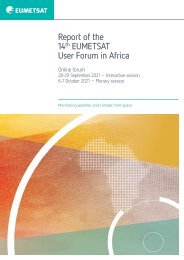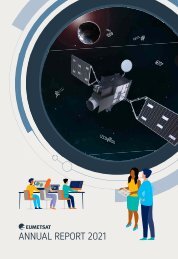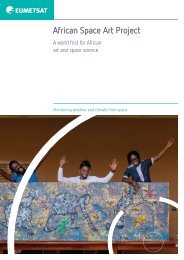EUMETSAT and Africa
European meteorological satellites at the service of Africa
European meteorological satellites at the service of Africa
- No tags were found...
You also want an ePaper? Increase the reach of your titles
YUMPU automatically turns print PDFs into web optimized ePapers that Google loves.
Extract from the Abidjan Summit Declaration<br />
“We agree to undertake efforts to halt <strong>and</strong> reverse<br />
environmental degradation, which has potentially significant<br />
implications for sustainable development, including related to<br />
security <strong>and</strong> migration, <strong>and</strong> for enhancing adaptive capacity<br />
to the adverse impacts of climate change <strong>and</strong> related shocks,<br />
<strong>and</strong> increase resilience to environmental degradation,<br />
desertification, health threats <strong>and</strong> humanitarian crises, <strong>and</strong><br />
increase resilience by addressing drivers of vulnerability.”<br />
The EU’s Copernicus Earth observation programme <strong>and</strong> the<br />
Global Monitoring for Environment <strong>and</strong> Security in <strong>Africa</strong><br />
(GMES <strong>and</strong> <strong>Africa</strong>) initiative will be central to achieving<br />
those aims.<br />
Contributing to the Integrated <strong>Africa</strong>n Strategy<br />
on Meteorology<br />
Other aims include:<br />
• To facilitate access to <strong>and</strong> use of globally available<br />
operational oceanography data from ocean-monitoring<br />
satellites (for example, Jason or Sentinel-3) <strong>and</strong> global ocean<br />
analysis <strong>and</strong> forecast centres (for example, the Copernicus<br />
Marine Service), as well as the production of <strong>Africa</strong>n-tailored<br />
marine forecast products based on these global data.<br />
• To facilitate access to, use <strong>and</strong> development of satellitebased<br />
meteorological products for aviation (for example,<br />
lightning detection, tropopause folding turbulences, fog<br />
detection <strong>and</strong> volcanic ash).<br />
• To increase <strong>Africa</strong>n capacities to develop tailored products<br />
based on satellite data through an <strong>Africa</strong>n Meteorological<br />
Satellite Application Facility as proposed in the Abidjan<br />
Declaration, <strong>and</strong> engage with international partners to combine<br />
or assimilate in situ observations, model outputs <strong>and</strong> satellitederived<br />
products to better address <strong>Africa</strong>n requirements.<br />
The Integrated <strong>Africa</strong>n Strategy on Meteorology (Weather<br />
<strong>and</strong> Climate Services) was first adopted during the <strong>Africa</strong>n<br />
Ministerial Conference on Meteorology (AMCOMET) in 2012.<br />
The revised strategy was presented <strong>and</strong> adopted at the<br />
March 2021 conference.<br />
The revised strategy highlights the importance of access to<br />
global sources of weather <strong>and</strong> climate data. It states that<br />
satellite data, global weather models <strong>and</strong> climate data are<br />
essential for national weather <strong>and</strong> climate services <strong>and</strong> will be<br />
secured for national meteorological <strong>and</strong> hydrological services<br />
to underpin economic growth <strong>and</strong> sustainable development.<br />
The strategy also makes explicit references to the importance of<br />
satellites operated by <strong>EUMETSAT</strong>. It aims to ensure sustainable<br />
access to <strong>and</strong> use of data from existing <strong>and</strong> future geostationary<br />
<strong>and</strong> polar-orbiting satellites, in particular, MTG.<br />
Left: Aerial view of<br />
Johannesburg, South <strong>Africa</strong><br />
(source: Adobe Stock)<br />
07









